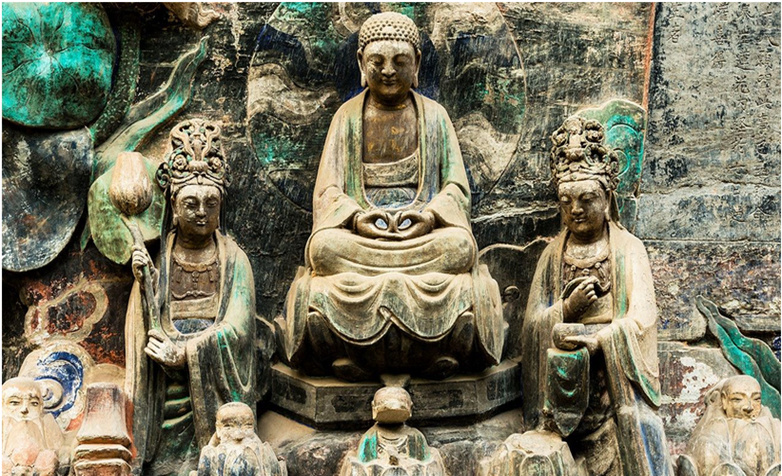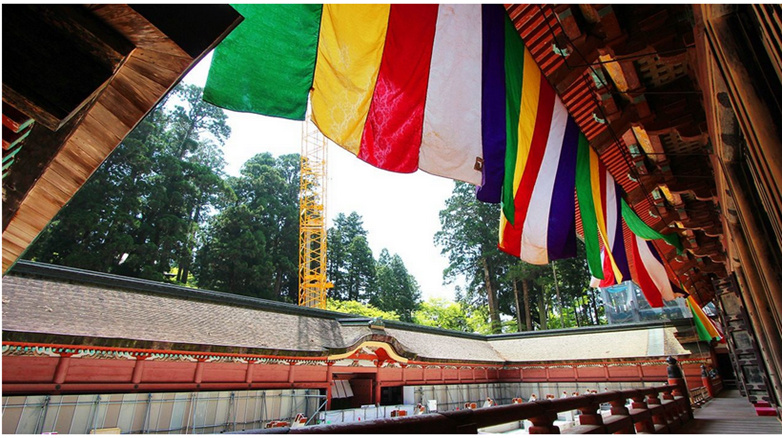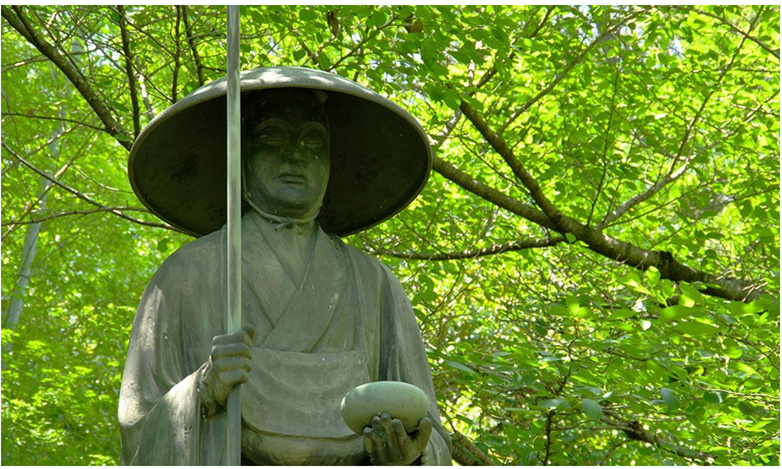Learn about the origins of Mahayana Buddhism

Five hundred years after the death of Buddha, a new version of Buddhism emerged, radically different from the original religion, and its new teachings spread along the Silk Road to China. The new version became known as Mahayana Buddhism or 'The Great Chariot'. In this part of the series, the author takes a look at how Shakyamuni's teachings reached China, and the dramatic transformations it underwent on its way to Japan.
Mahayana Buddhism takes form: anyone can become a Buddha
Buddhism spread from its beginnings in India about 2,500 years ago and became influential over a wide area of the Indian subcontinent and Central Asia. The decision of King Ashoka - of the Maurya dynasty - who ruled in the third century to convert to Buddhism was a fundamental development in the early history of this religion. It is believed that Buddhist teachings were known throughout India and expanded as far south as Sri Lanka around that time.
In Sri Lanka, this religion survived a turbulent history, and remains today in one form or another in its original form, as it first arrived on the island those centuries ago. Buddhist teachings then moved from Sri Lanka to Southeast Asia, where Buddhism remains a vital part of daily life in many countries to this day. The Theravada Buddhism (the name means ''school of elders'') practiced in Sri Lanka and Southeast Asia today remains close to the original Buddhism that formed in the years following the religion's emergence.

About 500 years after Shakyamuni's death, a new variety of Buddhism began to gain followers in northwestern India. This new version of the religion, which adopted doctrines significantly different from the original teachings of Buddha, spread from India along the Silk Road to China. These new teachings are collectively known as Mahayana Buddhism (or “The Great Chariot”).
What are the main characteristics of Mahayana Buddhism? The original teachings of Buddhism state that by joining the Sangha and becoming a monk a person can follow a strict set of meditative and spiritual practices to eventually reach enlightenment and liberation from suffering as a disciple of the Buddha. Buddhist disciples and practitioners who achieved enlightenment in this way were known as arhat (Sanskrit language) or arahant (Pali language). They were seen as admirable and praiseworthy figures who had achieved enlightenment to the same extent as Shakyamuni, but they were not thought to have the same profound compassion as the Buddha or the same profound understanding of the universe, nor were they venerated as much as the Buddha. They were holy men, but they remained disciples of Buddha. Buddhism in its original form taught that the ultimate goal of lay people was to follow the teachings of the Buddha and achieve enlightenment by becoming an arhat. Ordinary people cannot become Buddha themselves.
But in Mahayana Buddhism the teachings on enlightenment underwent radical changes, as the new version began to preach that the path to Buddha status was clear to anyone who followed the correct practices. Mahayana Buddhism taught that it is possible for anyone to attain equal status with the Supreme Being in the universe.
Buddha only told his followers in the sutras that they should strive to become arhats. He never urged them to become a Buddha like him, nor did he even remotely suggest that such a thing was possible. Therefore, the founders of Mahayana Buddhist sects had to compose new sutras that were completely different from the sacred texts that existed at that time. These new sutras followed the same basic premise in arguing that even ordinary people could become Buddhas.

In the New Sutra, Buddha says: ''It is true that I told you in another sutra that people who became monks and followed my teachings could become arhats, but those were only preliminary teachings. Indeed there is a deeper truth, and people who follow these practices on the basis of understanding this deeper system can become not only an Arhat, but a Buddha as well. “I will now explain this absolute truth to you, so listen carefully.”
Using this basic formula, the founders of Mahayana Buddhism created new texts that expressed what each sect believed to be the highest truth, and presented them as the words of Shakyamuni. These sutras became the sacred texts of Mahayana Buddhism, including the Heart Sutra, the Lotus Flower Sutra, the Pure Land Sutra, and various texts of esoteric Buddhism.
An engaging spin on original teachings
This diverse mixture of new sutras of Mahayana Buddhism arrived in China at the same time as the original form of this religion as taught by the historical Buddha, in the first and second centuries of the Common Era. All these various doctrines which contradicted each other were presented as 'Shakyamuni's teachings'.
The arrival of this variety of different and diametrically opposed philosophical ideas, supposedly originating from the same historical figure, initially created great confusion among Chinese intellectuals. They eventually found a way to deal with the apparent contradictions of a variety of texts. They decided that all of these radically different texts were the true teachings of the Buddha, who taught different things at different times in his life in proportion to his followers' ability to comprehend. Sometimes he limited himself to relative superficiality, and at other times he delved deeper into the facts he discovered about the universe. Chinese intellectuals attempted to use logic to reconcile the differences between different texts, by establishing varying levels of truth, while maintaining the basic belief that these teachings all emanate from the same person. They attempted to determine which sutras represented the highest level of truth, and accepted those teachings as the highest form of Buddhist teaching.

Of course, any decision as to which sutra represents the highest version of the Buddha's teachings depends on the individual judgment of the reader. People made different judgments and chose different sutras to represent the highest truth of this religion. The religion's followers increasingly took their beliefs from one set of scriptures and neglected others, and even long before multiple sects emerged alongside each other each believer venerated a different text or school of texts as the ultimate truth. This is the origin of the various schools of Mahayana Buddhism that exist to this day.
In most cases, Chinese people who read these various texts believing that they all stem from the words of the same historical Buddha tend to be drawn to the Mahayana texts. The reason for this is simple: in addition to being based on the foundations of original Buddhism, it was created by rearranging the content of the original teachings to make them more attractive in many ways. The mystical elements of the sutra texts coincide with the Chinese philosophical and religious view of the times.
Chinese Buddhism was therefore strongly characterized by taking on the character of Mahayana Buddhism. Many different sects and schools arose, but they all adopted Mahayana Buddhist texts as the basis of their doctrines. As for the original teachings of the historical figure of Buddha, there is a tendency to overlook them as being of secondary importance, so much so that the original teachings are disparagingly called “Hinayana Buddhism (the Lesser Vehicle).”

Original Buddhism is unknown for most of Japanese history
Buddhism entered Japan from China in the sixth century AD, and Japan became another country that believed in Mahayana doctrines as the true essence of Buddhism. Over the course of 15 centuries after that time, Japan developed its traditions as a nation of Mahayana Buddhism.
The teachings of early Buddhism in Japan were not widely known until the second half of the nineteenth century during the Meiji era (1868-1912). With the end of the policy of self-isolation after more than 200 years and the flow of information from the outside world, information spread for the first time about a different type of Buddhism in Sri Lanka and Southeast Asia that did not use the texts of the Mahayana Buddhist sutras familiar in Japan. The sutra texts used in those countries were written in Pali, an ancient language that had been used in northern India for centuries. It was inevitable to conclude that Buddhism as it existed in Sri Lanka and Southeast Asia was closest to the original form of this religion, and that the sacred texts of Mahayana Buddhism did not in fact transmit the true words of Shakyamuni. This understanding initially spread among scholars.
Today most scholars agree that Mahayana Buddhism does not represent the true original teachings of the historical Buddha. Within Buddhism itself there is generally a belief that although Mahayana Buddhism may not represent the original teachings of Shakyamuni, it is inspired by the same philosophy and worldview, and therefore deserves to be treated as a legitimate part of the Buddhist heritage.

In the first two parts of this series, I gave a brief description of how Buddhism arose from the teachings of the historical figure Shakyamuni in India and then looked at how a variety arose after the emergence of Mahayana Buddhism and how these new teachings spread to China and then to Japan. In the next part, I will highlight the position on Buddhism entering Japan for the first time in the sixth century, and I will try to explain why this religion followed a unique evolutionary path in Japan, which led to the emergence of religious forms that are not found anywhere else.
Source : websites

